二语习得作业精讲
- 格式:ppt
- 大小:342.00 KB
- 文档页数:38
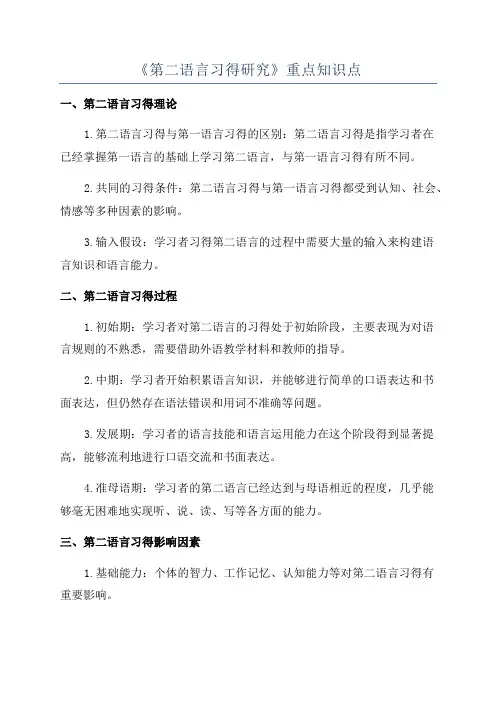
《第二语言习得研究》重点知识点一、第二语言习得理论1.第二语言习得与第一语言习得的区别:第二语言习得是指学习者在已经掌握第一语言的基础上学习第二语言,与第一语言习得有所不同。
2.共同的习得条件:第二语言习得与第一语言习得都受到认知、社会、情感等多种因素的影响。
3.输入假设:学习者习得第二语言的过程中需要大量的输入来构建语言知识和语言能力。
二、第二语言习得过程1.初始期:学习者对第二语言的习得处于初始阶段,主要表现为对语言规则的不熟悉,需要借助外语教学材料和教师的指导。
2.中期:学习者开始积累语言知识,并能够进行简单的口语表达和书面表达,但仍然存在语法错误和用词不准确等问题。
3.发展期:学习者的语言技能和语言运用能力在这个阶段得到显著提高,能够流利地进行口语交流和书面表达。
4.准母语期:学习者的第二语言已经达到与母语相近的程度,几乎能够毫无困难地实现听、说、读、写等各方面的能力。
三、第二语言习得影响因素1.基础能力:个体的智力、工作记忆、认知能力等对第二语言习得有重要影响。
2.学习策略:学习者在习得第二语言过程中采取的方法和策略也对习得效果产生影响。
3.情感因素:学习者对学习第二语言的情感态度、自信心等情感因素对习得过程产生影响。
4.环境因素:学习者所处的学习环境,包括学校、家庭、社会环境等对第二语言习得有影响。
四、第二语言习得教学策略1.输出与输入平衡:教师应当提供足够的输入,同时鼓励学习者进行口语和书面的输出。
2.合作学习:通过合作学习,学习者能够在与他人进行互动中提高第二语言的流利度和准确度。
3.语境创设:教师可以通过创设各种真实的语言交际情境来提高学习者的第二语言习得效果。
4.个性化教学:教师应根据学习者的个体差异,采取不同的教学策略和方法,满足每个学习者的学习需求。
以上是《第二语言习得研究》的重点知识点。
了解这些知识点能够帮助我们更好地理解学习者在学习第二语言过程中的习得情况,并且在实际的第二语言教学中有所借鉴。
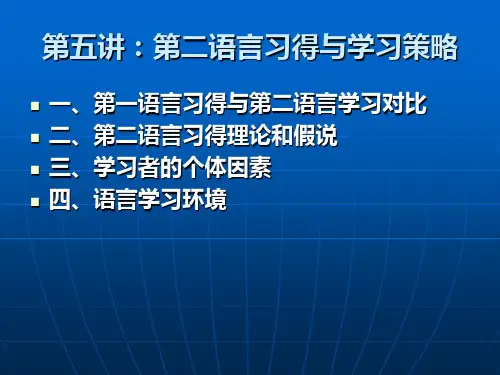
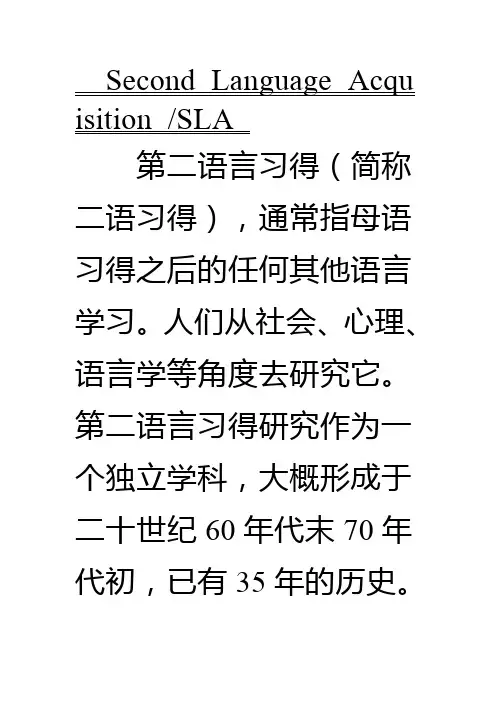
Second Language Acqu isition /SLA第二语言习得(简称二语习得),通常指母语习得之后的任何其他语言学习。
人们从社会、心理、语言学等角度去研究它。
第二语言习得研究作为一个独立学科,大概形成于二十世纪60年代末70年代初,已有35年的历史。
它对学习者的第二语言特征及其发展变化、学习者学习第二外语时所具有的共同特征和个别差异进行描写,并分析影响二语习得的内部因素和外部因素。
与其他社会科学相比,二语习得研究是个新领域,大都借用母语研究、教育学研究或其他相关学科的方法。
概括地说,这一领域的研究是为了系统地探讨二语习得的本质和习得的过程,其主要目标是:描述学习者如何获得第二语言以及解释为什么学习者能够获得第二语言。
到目前为止,二语习得的研究范围远比20世纪七八十年代广,涉及语言学、心理学、心理语言学、语用学,社会语言学等众多方面。
早期的第二语言习得理论是教学法的附庸,为服务提高教学质量而存在,1967年Larry Selinke r在《语言迁移》这本专著第一次提出中介语理论,第二语言习得理论从此有了自己的研究领域而开始成为一门独立的学科。
现时的第二语言习得研究涉及三大领域,即中介语研究,学习者内部因素研究和学习者外部因素研究。
1994年美国费城Temple 大学教育学院二语英语教学教授Rod Ellis撰写巨著《第二语言习得研究》,成为该领域的经典教科书。
该书共分七个部分。
第一部分勾画了整本书的概念框架。
第二部分总结了有关学习者语言本质的主要理论,包括学习者错误,发展模式,语言变项和语用特征。
第三部分从外部因素解释第二语言的习得,主要阐述社会因素和输入/交互的作用。
第四部分从内部因素解释第二语言的习得,包括语言迁移、认知论解释和语言普遍性。
第五部分将讨论的重点从学习转移到学习者,论述了第二语言习得的个体差异和学习策略。
第六部分是关于课堂英语教学的论述,讨论了课堂交互和正规教学的有关理论。
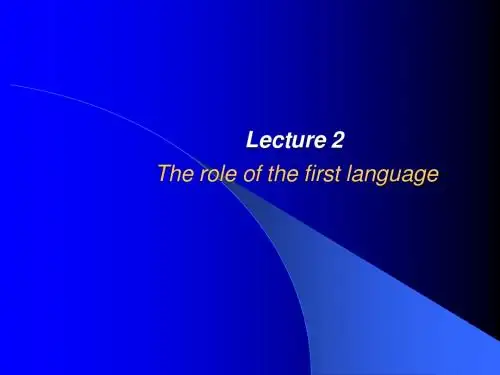

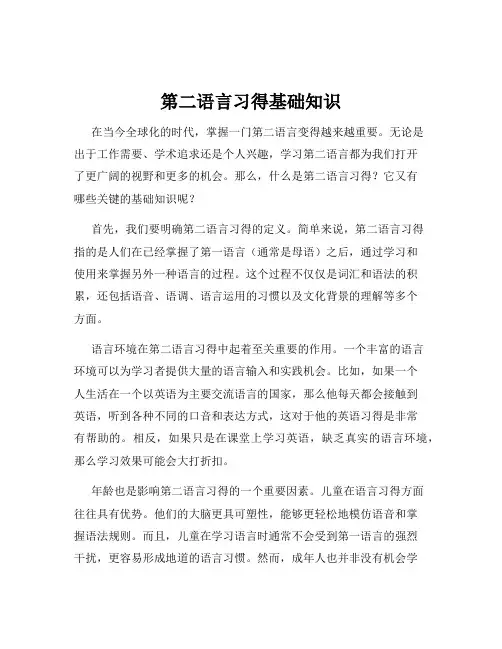
第二语言习得基础知识在当今全球化的时代,掌握一门第二语言变得越来越重要。
无论是出于工作需要、学术追求还是个人兴趣,学习第二语言都为我们打开了更广阔的视野和更多的机会。
那么,什么是第二语言习得?它又有哪些关键的基础知识呢?首先,我们要明确第二语言习得的定义。
简单来说,第二语言习得指的是人们在已经掌握了第一语言(通常是母语)之后,通过学习和使用来掌握另外一种语言的过程。
这个过程不仅仅是词汇和语法的积累,还包括语音、语调、语言运用的习惯以及文化背景的理解等多个方面。
语言环境在第二语言习得中起着至关重要的作用。
一个丰富的语言环境可以为学习者提供大量的语言输入和实践机会。
比如,如果一个人生活在一个以英语为主要交流语言的国家,那么他每天都会接触到英语,听到各种不同的口音和表达方式,这对于他的英语习得是非常有帮助的。
相反,如果只是在课堂上学习英语,缺乏真实的语言环境,那么学习效果可能会大打折扣。
年龄也是影响第二语言习得的一个重要因素。
儿童在语言习得方面往往具有优势。
他们的大脑更具可塑性,能够更轻松地模仿语音和掌握语法规则。
而且,儿童在学习语言时通常不会受到第一语言的强烈干扰,更容易形成地道的语言习惯。
然而,成年人也并非没有机会学好第二语言。
成年人具有更强的认知能力和学习策略,能够更有针对性地进行学习。
动机是推动第二语言习得的内在动力。
如果一个人学习第二语言是出于强烈的内在动机,比如对目标语言的文化感兴趣、渴望与更多的人交流,那么他往往会更有积极性和主动性,学习效果也会更好。
相反,如果只是为了应付考试或者迫于外界压力而学习,那么一旦失去了这些外部因素的驱动,学习很可能就会停滞不前。
学习策略在第二语言习得中也不可忽视。
好的学习策略可以帮助学习者更高效地学习。
例如,制定学习计划、多听多读多说多写、利用各种学习资源(如电影、歌曲、书籍等)、与母语者交流等等。
同时,学习者还要不断反思自己的学习方法,及时调整策略,以适应不同的学习阶段和学习内容。
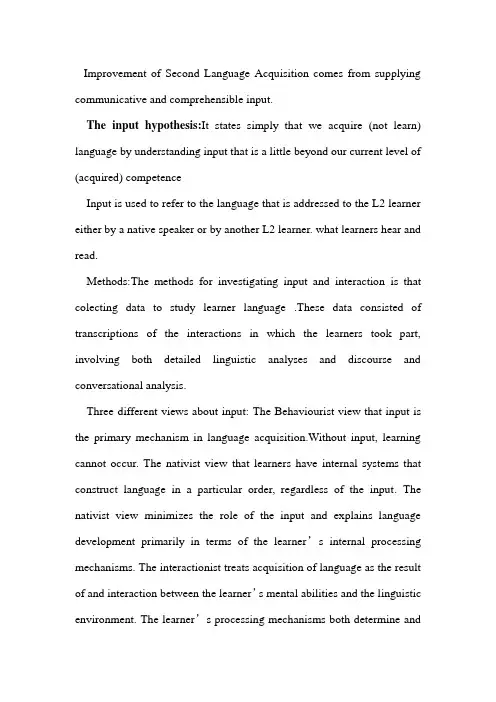
Improvement of Second Language Acquisition comes from supplying communicative and comprehensible input.The input hypothesis:It states simply that we acquire (not learn) language by understanding input that is a little beyond our current level of (acquired) competenceInput is used to refer to the language that is addressed to the L2 learner either by a native speaker or by another L2 learner. what learners hear and read.Methods:The methods for investigating input and interaction is that colecting data to study learner language .These data consisted of transcriptions of the interactions in which the learners took part, involving both detailed linguistic analyses and discourse and conversational analysis.Three different views about input: The Behaviourist view that input is the primary mechanism in language acquisition.Without input, learning cannot occur. The nativist view that learners have internal systems that construct language in a particular order, regardless of the input. The nativist view minimizes the role of the input and explains language development primarily in terms of the learner’s internal processing mechanisms. The interactionist treats acquisition of language as the result of and interaction between the learner’s mental abilities and the linguistic environment. The learner’s processing mechanisms both determine andare determined by the nature of the input.The behaviourist view emphasizes the importance of the linguistic environment, which is treated in terms of stimuli and feedback. The nativist view minimizes the role of the input and explains language development primarily in terms of the learner’s internal processing mechanisms. The interactionist view sees language development as the result both of input factors and of innate mechanisms. Language acquisition derives from the efforts of the learner and his interlocutors and involves a dynamic interplay between external and internal factors. Input and interaction in natural settingsCaretaker talkWhen caretakers speak to young children who are in the process of acquiring their L1, they typically adjust their speech in a number of ways. The register that results has been referred to variously as ‘baby-talk’, ‘motherese’, ‘caretaker talk’, and ‘child-directed language’Motherese concentrates on the “here and now”rather than on the abstract and remote.The features of caretaker talkIt is more ungrammatical than speech addressed to adults;It is simpler;It is more redundant.Foreigner talkIn natural settings, input has been considered in terms of foreigner talk. When native speakers address learners, they adjust their normal speech in order to facilitate understanding. These adjustments, which involve both language form and language function, constitute ‘foreigner talk’. The modified speech used by native speakers when talking to L2 learners. It was first studied by Charles Ferguson in 1975. It can promote communication. Gass and Varonis (1994) have found that native speaker modifications are more frequent in two-way communication because conversation provides the native speaker with feedback from the learner and thus enables him to estimate the amount of adjustment required. It can signal speakers' attitude towards their interlocutors. It can teach the target language implicitly.Input and interaction in classroom settingsTeacher talkAs the main source of input in classroom setting, teacher talk is the speech produced by the teacher in the classroom in order to pass on knowledge or to organize the class or for some interpersonal purposes. Teacher talk parallels that of foreign talk.Teacher talk refers to the language of teaching tasks as prescribed in textbooks and the language the teacher uses to perform such teaching tasks as paragraphing words or sentences or illustrating grammar rules.In general, the research confirms the finding for L1 classroom ---namely, that the teacher takes up about two-thirds of the total time. There is considerable evidence of variability among teachers and programs, but the general picture is again one of teacher dominance in that teachers are likely to explain, question and command and learners to respond. Teachers, like native speakers in general, slow down their rate of speech when talking to learners in comparison to other native speakers and also do so to a greater extent with less proficient learners. However, there is considerable variability among teachers. Teachers are likely to make use of longer pauses when talking to learners than to other native speakers. There have been few studies which have attempted to quantify these aspects of teacher talk, but teachers appear to speak more loudly and to make their speech more distinct when addressing L2 learners. teachers vary their choice of words in accordance with the learners’proficiency level.Firstly, a teacher can improve his Teacher talk to create harmonious atmosphere in foreign language teaching. Secondly, a good teacher needs to make sure that all students get the feeling of being encouraged. It is the best way for teacher to use the linguistic tools to verbally encourage students, not by pointing out that students’weaknesses do not matter, but by highlighting their strengths.Interlanguage talkThe language that learners address to each other (ILT constitutes theprimary source of input for many learners). ILT provides learners with opportunities for negotiating meaning as occur in foreigner talk. Interaction HypothesisInteraction Hypothesis claims that learners acquire through talking with others. According to this hypothesis, learners are likely to have misunderstandings in their interaction because they do not know the language perfectly. In this situation, the learner will try to use some strategies to express his idea clearly, such as repeating, using other words and simple structures.Through negotiation of meaning, both the speaker and the listener clarify the contents, verify the understanding, make communicative respond and give feedback to each other, as well as a chance to examine his own assumption.The Interaction hypothesis is a theory of second-language acquisition which states that the development of language proficiency is promoted by face-to-face interaction and communication.The idea existed in the 1980s, but is usually credited to Michael Long for his 1996 paper The role of the linguistic environment in second language acquisition.There are some principles about interaction hypothesis1. The linguistic characteristics of target language input need to be made salient.2. Learners should receive help in comprehending semantic and syntactic aspects of linguistic input.3. Learners need to have opportunities to produce target language output.4. Learners need to notice errors in their own output5. Learners need to correct their linguistic output.6. Learners need to engage in target language interaction whose structure can be modified for negotiation of meaning.7. Learners should engage in L2 tasks designed to maximise opportunities for good interaction.OutputOutput (producing language) is also necessary for language learning - Output Hypothesis (Swain, 1995). Understanding language and producing language are different skills, and the comprehensible input is not enough to push the learner’s linguistic competence to a higher level. Output, the language that the learner himself produces, is an important part of the language acquisition as well. output is the result of learning which actually exists in oral or written forms. Output is also of great significance to L2 acquisition. There are three functions about output. Attention function indicates that the target language output causes the learner to pay more attention to the difference between what he wants to say and what he has said, which will stimulate the conscious learning.Confirmation function stresses that learner has the upper hands to identify and correct. Meta-language function means that when producing the language, the learner realizes his own problems which the feedback system in the brain makes the learner to respond and correct.Language acquisition is a bilateral interaction process in which the input and output are closely related. To cultivate the linguistic competence, the learners not only need to listen, but also need to open their mouths to speak and pick up their pens to write. In practice, learners can build up their language sense and perfect their communications, which are favorable conditions for the language study. The balance between language input and language output plays an import ant role in second language acquisition.Once we notice the balance betw een language input and output,we will become more efficient in language learning .If we ignore this balance, especially only focus on language input,most of us are incapable in oral s peaking and writing.To sum up,teachers should adopt different kinds of te aching methods on the basis of the balance between language input and o utput,so that their students can have an all-round development capability i n second language acquisition.。
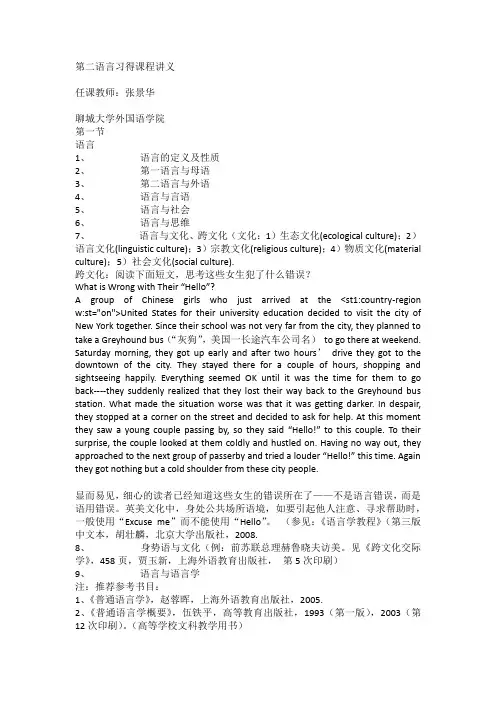
第二语言习得课程讲义任课教师:张景华聊城大学外国语学院第一节语言1、语言的定义及性质2、第一语言与母语3、第二语言与外语4、语言与言语5、语言与社会6、语言与思维7、语言与文化、跨文化(文化:1)生态文化(ecological culture);2)语言文化(linguistic culture);3)宗教文化(religious culture);4)物质文化(material culture);5)社会文化(social culture).跨文化:阅读下面短文,思考这些女生犯了什么错误?What is Wrong with Their “Hello”?A group of Chinese girls who just arrived at the <st1:country-region w:st="on">United States for their university education decided to visit the city of New York together. Since their school was not very far from the city, they planned to take a Greyhound bus(“灰狗”,美国一长途汽车公司名)to go there at weekend. Saturday morning, they got up early and after two hours’drive they got to the downtown of the city. They stayed there for a couple of hours, shopping and sightseeing happily. Everything seemed OK until it was the time for them to go back----they suddenly realized that they lost their way back to the Greyhound bus station. What made the situation worse was that it was getting darker. In despair, they stopped at a corner on the street and decided to ask for help. At this moment they saw a young couple passing by, so they said “Hello!” to this couple. To their surprise, the couple looked at them coldly and hustled on. Having no way out, they approached to th e next group of passerby and tried a louder “Hello!” this time. Again they got nothing but a cold shoulder from these city people.显而易见,细心的读者已经知道这些女生的错误所在了——不是语言错误,而是语用错误。

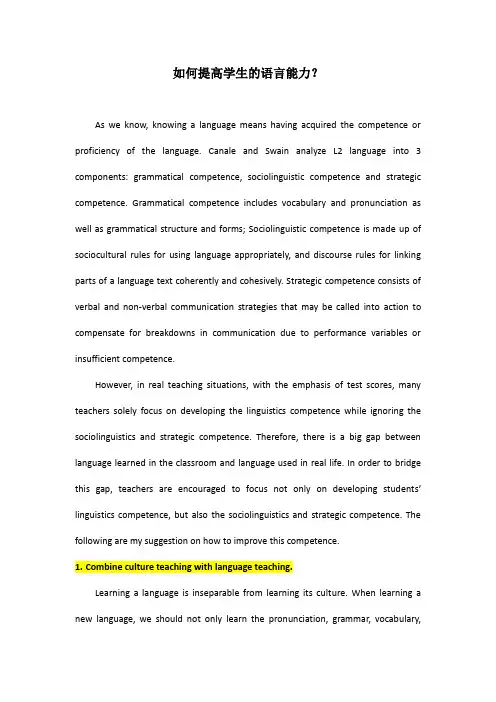
如何提高学生的语言能力?As we know, knowing a language means having acquired the competence or proficiency of the language. Canale and Swain analyze L2 language into 3 components: grammatical competence, sociolinguistic competence and strategic competence. Grammatical competence includes vocabulary and pronunciation as well as grammatical structure and forms; Sociolinguistic competence is made up of sociocultural rules for using language appropriately, and discourse rules for linking parts of a language text coherently and cohesively. Strategic competence consists of verbal and non-verbal communication strategies that may be called into action to compensate for breakdowns in communication due to performance variables or insufficient competence.However, in real teaching situations, with the emphasis of test scores, many teachers solely focus on developing the linguistics competence while ignoring the sociolinguistics and strategic competence. Therefore, there is a big gap between language learned in the classroom and language used in real life. In order to bridge this gap, teachers are encouraged to focus not only on developing students’ linguistics competence, but also the sociolinguistics and strategic competence. The following are my suggestion on how to improve this competence.bine culture teaching with language teaching.Learning a language is inseparable from learning its culture. When learning a new language, we should not only learn the pronunciation, grammar, vocabulary,sentence structure and idioms, but also learn how to see the world as native speakers do. That is to say, we should learn the ways in which the foreign language reflects the ideas, customs, and behavior of that society and learn to understand their language of the mind. We need to learn enough about the language’s culture so that we can communicate in the target language properly to achieve not only the linguistics competence but also the pragmatics or communicative competence as well.ing communicative language teaching approach and Task-Based Language teaching approach in English classroomThe goal of communicative approach is to develop students’ communicative competence, which includes knowledge about the language and knowledge about how to use the language appropriately in communicative situations. TBLT is a further development of communicative language teaching. It stressed the importance to combine form-focused teaching with communication-focus teaching. It views learning as a set of communicative activities in which communication and interaction are as important as accuracy and fluency.anize various communicative activities .Teacher should create real-life communicative situation for students to practice using the language in social context. Students will therefore learn to interact with others and enhance their ability to use the target language effectively. Teachershould organize various interesting, motivating activities for students to learn. For example, English debate, English drama, interview, role playing.4.Provide students with authentic teaching materials.Authentic materials "contextualize" the language learning. Authentic materials help to bridge the gap between the language being taught in the classroom and the language used by real people in real situations in the real world. Authentic materials help motivate learners learn the language by making them feel that they are learning the 'real' language. Teachers are encouraged to provide students with authentic and sufficient learning models. Conversations in the native countries under natural environment would be a good choice.5.Create a positive language environmentAs we know that language environment is essential in language learning. If we put a Chinese student into English speaking countries, his English competence would improve significantly in a short time. Therefore, teacher should create a positive language environment for students. For example, teacher give instructions in English class and encourage students to use English to communicate with their partners. balance the students’ input and output of the language, adjusting the time of teachers’ teaching and student’s learning.。
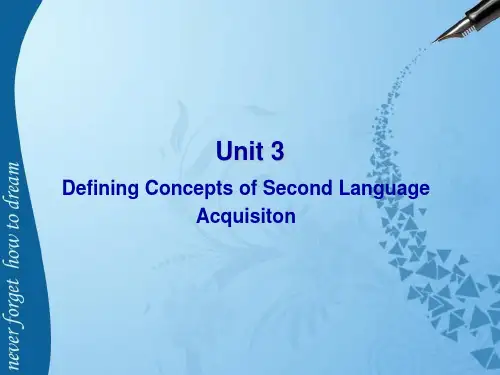
⼆语习得“三⼤假说”与任务型教学-精选教育⽂档⼆语习得“三⼤假说”与任务型教学1.引⾔任务型语⾔教学是20世纪80年代第⼆语⾔习得和外语教学研究相结合的⼜⼀重要的语⾔习得模式和外语教学理论成果。
它以完成具体任务的欲望为动⼒,以⽤语⾔做事作为完成任务的过程,以展⽰任务成果体现教学的成效。
⼆语习得指的是“在⾃然的或有指导的情况下,通过有意识学习或⽆意识吸收掌握母语以外的⼀门语⾔的过程”。
就学科教学来说,任务型教学作为第⼆语⾔教学途径,⼆语习得研究对其有直接的指导意义。
任务型教学借鉴了⼆语习得“三⼤假说”的基本理论,对⼆语习得领域的研究成果采取了兼收并蓄的⽅式,建构了⾃⼰第⼆语⾔教与学的理论框架。
2.“任务”的界定任务型语⾔教学中最关键的概念是“任务”。
能否正确理解并实施任务型语⾔教学,很⼤程度上取决于对任务的本质及特征的认识。
Nunan(1989)认为任务是⼀项必须涉及语⾔的活动,它的整体⽬标是激发学习者使⽤所学的语⾔,所以应该是以语⾔“意义”为中⼼的。
Ellis(2003)给任务下的定义很简单,却指出任务最本质的东西,“任务是那些主要以表达意义为⽬的的语⾔运⽤活动”。
不涉及真正意义交流的活动,不能称为任务。
任务型活动不同于⼀般的课堂练习活动,它侧重于对学⽣完成交际任务能⼒和策略的培养,是有意义的交际性活动,⽽不仅仅是⼀种机械性的语⾔操练。
任务是学习者为了做成某件事情,⽤⽬的语进⾏的有交际⽬的的活动,在“⽤语⾔做事”的过程中,学习者始终处于⼀种积极的、主动的学习⼼理状态,任务的参与者之间的交际过程是⼀种互动的过程。
为了完成任务,学习者以“意义”为中⼼,尽⼒调动各种语⾔和⾮语⾔资源进⾏“意义”共建,以达到解决某种交际问题的⽬的。
任务往往有⼀个⾮语⾔的结果,衡量⼀个任务是否成功,要看这个任务有没有⼀个结果。
3.⼆语习得“三个假说”与任务型教学任务的作⽤在于提供语⾔的输⼊和输出加⼯,这对于语⾔习得是必要的。